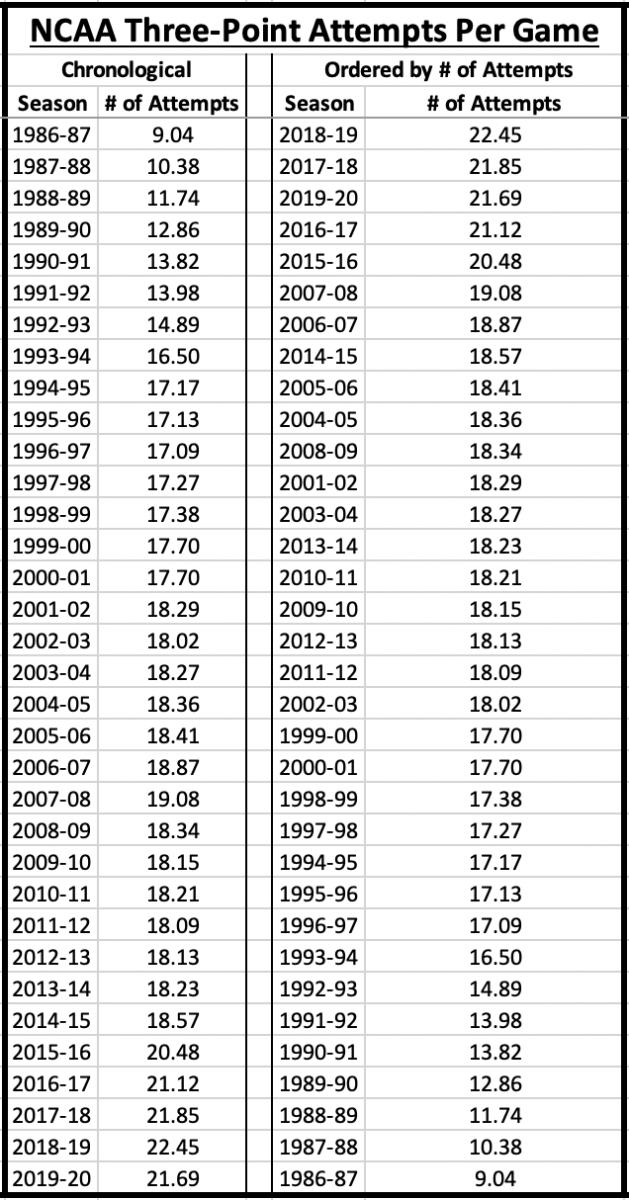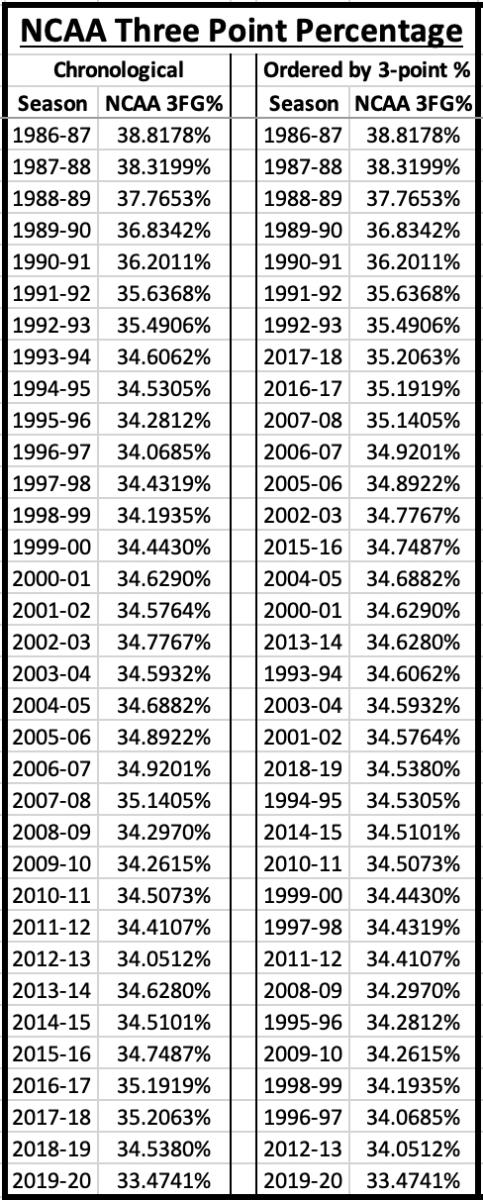Report: 2019-20 Yielded the Lowest Three-Point Shooting Percentage in NCAA History

Prior to the 2019-20 college basketball season, the NCAA decided to move back the three-point line for just the second time since the three-pointer debuted in men’s basketball in 1986-87 at 19 feet, nine inches.
The three-point line remained at this distance for 22 years until the 2008-09 season, at which point the line moved back one foot to 20 feet, nine inches.
The newly agreed upon distance for the 2019-20 season matched the FIBA International length—22 feet, one-and-three-quarter inches—which added one foot, four-and-three-quarter inches. Division I enacted the change in 2019-20, while Divisions II and III will do so in 2020-21.
This most recent move backward represents a rather drastic shift. Certainly, there were bound to be resulting repercussions across the landscape of Division I. Would percentages drop? Would attempts go down? Would fewer players attempt three-pointers? Would teams alter their scoring and/or personnel approach?
In order to find out the answers, during the COVID-19 quarantine months I have been slowly, but surely, gathering the data from each Division I team for every season the three-point shot has been in existence (1986-87 through 2019-20).
I owe a big debt of gratitude to Sports-Reference.com for their robust database of stats. I am also indebted to many schools around the country for providing decades-old box scores to help fill in the gaps.
HOW THREE-POINT USAGE HAS CHANGED OVER TIME
When the three-pointer was first officially used across the entirety of Division I in 1986-87, teams attempted an average of just 9.04 threes per game, making 3.51 of them. By the time the 2018-19 season rolled around (the year prior to the most recent distance change), the number surged to 7.75 makes per game on 22.45 attempts.
Teams have clearly become more reliant on the three as time has gone on and analytics have revealed the high value of a three-pointer. As the importance of the shot has grown, teams have also adjusted their personnel to include a higher number of players who can shoot from outside. Frontcourt players are no longer valuable investments if they aren’t able to step out and knock down a shot.
The following charts reveal how three-point makes and attempts have steadily grown over the years.


OBSERVATIONS ON THREE-POINT MAKES AND ATTEMPTS
As previously mentioned, the number of three-point attempts began at 9.04 per team, per game in 1986-87 and rose to a height of 22.45 attempts in 2018-19. The number of three-point makes began at 3.51 per team per game in 1986-87 and rose to a height of 7.75 makes in 2018-19.
From 2018-19 to 2019-20, the drop in three-point attempts went from 22.45 to 21.69 per team, per game (-0.76 attempts), while the reduction in makes was 7.75 down to 7.26 (-0.49). Both of these changes are the largest drop from one season to the next.
The season yielding the second-largest drop-off in three-point makes and attempts was 2008-09. From 2007-08 to 2008-09, the rate of change in three-point attempts per team, per game was 19.08 down to 18.34 (-0.74 attempts per game). In the same span of time three-point makes per team, per game dropped from 6.70 to 6.29 (-0.41 makes per game).
Do these years stand out to you? They should.
2008-09 and 2019-20 were the two years that the NCAA moved the three-point line back. As you would imagine, the two greatest drop-offs in both three-point attempts and makes occurred in the two seasons where the NCAA moved the line back. In both categories, the drop-off was more pronounced in 2019-20 than 2008-09, likely due to the adjustment being over a foot in difference from one season to the next.
There were certainly other years in which the number of makes and attempts dropped from one season to the next. However, these were the only two seasons where the drop-off was more than one-tenth of a make or three-tenths of an attempt.
A lower number of three-point attempts and makes from one season to the next is the exception (seven times with attempts and 10 times with makes over the course of 33 years). The consistent reality is that the number of three-point attempts and makes per team, per game has steadily risen over the course of those same 33 years.
In the case of both attempts and makes, the biggest such jump occurred from 2014-15 to 2015-16. In that span, teams attempted 1.91 more threes per game (20.48 up from 18.57). Along with more attempts came more makes. Teams went from averaging 6.41 made threes per game in 2014-15 to 7.12 in 2015-16 (+0.71).
So what happened from 2014-15 to 2015-16 to cause such a drastic increase in attempted and made threes?
The NCAA didn’t move the line closer.
It wasn’t a new ball.
Why did teams go from shooting 212,335 threes in 2014-15 to attempting 22,497 more (234,832 in total) in 2015-16?
Would you like to know the reason?
It’s all because of a little point guard from Davidson College named Steph Curry.
Right after the NCAA wrapped up their season in 2015, the Steph Curry-era Warriors won their first championship on the back of a three-point barrage from Curry and his splash brother, Klay Thompson.
College coaches and players certainly took note of this development (which, in truth, had been growing for quite some time), and made a conscious effort to shoot more threes in 2015-16.
Would you like to know the other Steph Curry factor? The 2015-16 season was the year Curry became the first (and still only) man to hit 400-plus threes in a single season.
So the Warriors had just won the first championship playing a lot of small ball, and now Curry was busy re-writing his own three-point record book. Of course that level of three-point shooting is going to filter down into the college ranks.
OBSERVATIONS ON THREE-POINT PERCENTAGE CHANGE
This is the big question: How did the 2019-20 change in three-point distance affect shooting accuracy?
Well, here’s the chart:

Historically, NCAA teams have collectively shot three-pointers somewhere between 34.0 and 35.9%. That fact is so reliable and consistent that in literally every season from 1991-92 through 2018-19, the teams of NCAA Division I combined to shoot in that range.
The outliers are the seasons prior to 1991-92, which all feature a three-point accuracy greater than 36%. This fact is likely due to the fewer attempted threes and to the attempts coming from a fewer number of shooters.
In fact, we could go so far as to say that, as a rule, the combined three-point accuracy of NCAA Division I falls somewhere between 34.0 and 34.9% on an annual basis. It’s a remarkably consistent statistic. Twenty-three of the 34 seasons the three-point shot has been in existence in college, the comprehensive percentage has fallen in this window.
Only five times has the percentage fallen in the 35.0-35.9 range. The first two occurrences were 1991-92 (35.64%) and 1992-93 (35.49%) which are the latter two years of the initial surge of higher three-point shooting. The other three incidences happened in the immediate lead-up to the three-point line being pushed back. The higher shooting percentage was the writing on the wall that change was coming.
2007-08 – 35.14% three-point shooting.
2008-09 – New three-point distance.
2016-17 – 35.20% three-point shooting.
2017-18 – 35.21% three-point shooting.
2019-20 – New three-point distance.
The collective percentage had come close to falling under 34%, but it had never happened. Two occasions were within a tenth of a percentage point from falling below that 34% threshold. In 1996-97, the NCAA-wide percentage was 34.07 and in 2012-13 it was 34.05.
So we now circle back around to the biggest question of all: How was three-point shooting accuracy affected in 2019-20 by the shift back to 22 feet, one-and-three-quarter inches?
The answer:
2019-20 was the first time in the history of men's college basketball that the NCAA Division I-wide three-point shooting accuracy was below 34%.
The three-point shot has been in effect since 1986-87. In those first 34 seasons, never has the percentage dropped below 34%. But now it has. And it’s not like the number was just barely below 34, at say, 33.9%. No, no. The number is 33.47%.
The previous low is the aforementioned 34.05%, in 2012-13. At 33.47%, the 2019-20 shooting accuracy number is over half a percentage point lower than the previous low.
This was also the first time in history that the three-point shooting percentage dropped by more than one percentage point from one season to the next. In 2018-19, the teams combined to shoot 34.54% from deep. Given the already-mentioned 33.47% rate in 2019-20, that means NCAA-wide three-point shooting tumbled by 1.07 percentage points this past season.
APPLICATION
What exactly are coaches supposed to do with this information?
Should they stop shooting threes as much? Should they limit the number of players who have the green light to pull up from deep? More shooting drills?
It’s not like they can give up. For players with NBA aspirations, they’ve got another nineteen-and-one-quarter inches to go before reaching the League’s 23 feet, nine inches distance.
The sheer volume of attempted threes did go down in 2019-20 (240,649 attempts, 681.73 per team), but only to a level similar to the number of attempts in 2016-17 (243,067 attempts, 692.50 per team). The makes did not regress at the same level as the attempts; they regressed a year further back. The number of makes from 2019-20 (80,555 makes, 228.20 per team) backslid to a level more synonymous with the 2015-16 season (81,601 makes, 232.48 per team), thus leading to the first-ever sub-34% three-point shooting average.
Listen folks, the three-point revolution is here.
Are teams going to stop shooting threes as much? No.
Rather than be bothered that numbers were at an all-time historic low this past season, it is plainly evident that coaches and players will instead be working hard to hone their craft as the world searches for the next Steph Curry.
Will the three-point percentage rebound in 2020-21 into the typical 34% range? Or have we reached a new normal in three-point shooting?
You can follow us for future coverage by clicking “Follow” on the top right hand corner of the page.
Send Isaac Schade an email to talk more about this article.
Follow us on Twitter: @SI_Heels | @isaacschade
Please post any comments below!
